Gelli printing is an exciting and creative way to make textured prints on paper, fabric, and other surfaces. Whether you are an artist looking to add texture to your artwork or a DIY enthusiast exploring new techniques, Gelli printing offers endless possibilities. The key to achieving great results lies in selecting the right materials, especially the acrylic paint you use.
We will explore the best acrylic paint for Gelli printing, providing you with everything you need to know to make your printing process smoother and more vibrant. We will also discuss factors to consider when choosing acrylic paint, the top paint brands, and offer tips on how to get the most out of your Gelli printing experience.
What is Gelli Printing?
Before diving into the best acrylic paints, let’s first understand what Gelli printing is. Gelli printing is a form of monoprinting that involves using a gelatin-like plate to transfer paint or ink onto a surface, such as paper, fabric, or canvas. Unlike traditional printmaking, Gelli printing allows for spontaneous creativity and texture manipulation. It’s a great technique for adding layers, patterns, and visual interest to your artwork.
The process involves applying acrylic paint to a flexible gel plate, and then using various tools (stamps, stencils, brushes, and texture plates) to manipulate the paint before pressing paper onto the plate to create prints. One of the most significant advantages of Gelli printing is that you can experiment freely without the worry of making mistakes.
Why Choosing the Right Acrylic Paint Matters
Choosing the best acrylic paint for Gelli printing is crucial because the paint’s consistency, opacity, and drying time can significantly impact your prints. Here are some factors to consider when selecting acrylic paint for Gelli printing:
- Consistency: The ideal acrylic paint for Gelli printing should have a creamy consistency that is easy to apply to the plate. Paints that are too thick may leave uneven coverage, while paints that are too runny can cause streaks and less-than-ideal textures.
- Opacity: You will need a variety of opaque and transparent paints to create different layers and effects. Opaque paints are great for solid colors and backgrounds, while transparent paints allow you to build layers and create interesting effects.
- Drying Time: Acrylic paint dries quickly, which can be both an advantage and a challenge. For Gelli printing, you’ll want to choose a paint that doesn’t dry too quickly on the plate, giving you enough time to work with it. Slower-drying acrylic paints give you more flexibility and room to play with textures.
- Viscosity: Some acrylic paints have a thicker or thinner viscosity, which affects how they spread and interact on the Gelli plate. A medium viscosity acrylic paint is usually the most versatile for this technique.
- Pigment Load: The pigment load of acrylic paint refers to the concentration of color pigments in the paint. A high pigment load ensures rich, vibrant prints, while a low pigment load can produce more subtle effects.
The Best Acrylic Paint for Gelli Printing
Now that we know what to look for, let’s explore some of the best acrylic paints for Gelli printing, considering their texture, opacity, and versatility.
1. Golden Heavy Body Acrylics
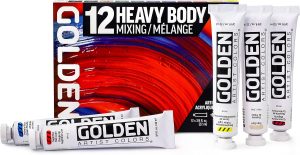
Golden Heavy Body Acrylics are a favorite among many artists and printmakers due to their rich pigmentation, smooth consistency, and excellent coverage. These paints have a thicker consistency, which works well for Gelli printing, allowing for textured effects without becoming too runny. They are highly pigmented, ensuring vibrant and bold prints that will stand out.
Why It’s Great for Gelli Printing:
- Thick consistency perfect for creating textured prints.
- Rich pigmentation that delivers vibrant colors.
- Wide range of colors available for endless creative possibilities.
Best For: Artists looking for high-quality paint with strong opacity and texture.
2. Liquitex Basics Acrylic Paint
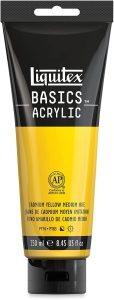
Liquitex Basics Acrylic Paint is an affordable, high-quality paint that offers great value for money. It is smooth and easy to apply, making it ideal for Gelli printing. While it is a student-grade paint, it doesn’t compromise on color richness, and the paint has a nice medium consistency that works well on the Gelli plate.
Why It’s Great for Gelli Printing:
- Affordable price point.
- Smooth, creamy consistency that is easy to spread.
- Wide range of colors for versatile printing.
Best For: Beginners or those on a budget who still want quality performance.
3. Daler-Rowney System 3 Acrylic Paint
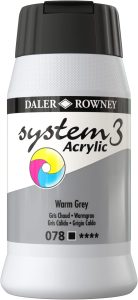
Daler-Rowney System 3 Acrylic Paint is known for its smooth consistency and vibrant colors. This acrylic paint is designed for artists and offers a balance of affordability and performance. It has a medium viscosity, making it easy to apply without being too thick or runny. It also has a good drying time, which is ideal for working with Gelli plates.
Why It’s Great for Gelli Printing:
- Medium viscosity for controlled application.
- Fast-drying, ideal for layered printing.
- Good opacity for solid prints and backgrounds.
Best For: Intermediate artists looking for a mid-range paint with great versatility.
https://amzn.to/42mJron4. DecoArt Americana Acrylics
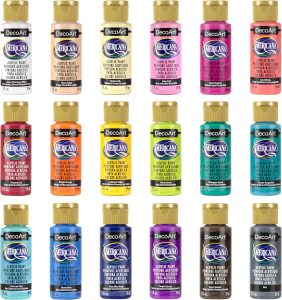
DecoArt Americana Acrylics are a highly affordable and versatile option for Gelli printing. These paints have a creamy consistency and come in a wide variety of colors. They are known for their smooth application, vibrant finishes, and long-lasting coverage. Though more affordable, the quality of DecoArt Americana paints holds up very well for Gelli printing.
Why It’s Great for Gelli Printing:
- Smooth consistency and great coverage.
- Affordable with a large selection of colors.
- Can be used for both thick and thin layers.
Best For: Budget-conscious artists who still want a reliable paint for Gelli printing.
5. Amsterdam Expert Acrylic Paint
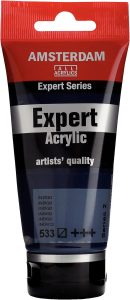
Amsterdam Expert Acrylic Paints are known for their smooth texture and excellent adhesion. These paints have a creamy consistency that’s perfect for creating smooth, detailed prints. With high pigmentation, the colors are rich and vibrant, making them a great choice for creating striking artwork on the Gelli plate.
Why It’s Great for Gelli Printing:
- High pigment concentration for rich, vibrant colors.
- Smooth, even application for controlled texture.
- Consistent viscosity ideal for Gelli printing.
Best For: Artists who want high-quality, vibrant paint for bold Gelli prints.
6. Matisse Structure Acrylics
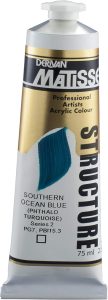
Matisse Structure Acrylics are a professional-grade paint that offers thick, creamy texture and superb pigmentation. This paint is perfect for Gelli printing if you want to add depth and texture to your prints. The thick consistency of Matisse Structure Acrylics allows you to manipulate the paint in many ways, whether you want to create texture or a smooth finish.
Why It’s Great for Gelli Printing:
- High pigment load for rich, deep color.
- Thick, buttery consistency perfect for texture.
- Slow drying time allows for more control during printing.
Best For: Professional artists or those looking for thick, textured effects.
7. Craft Smart Acrylic Paint
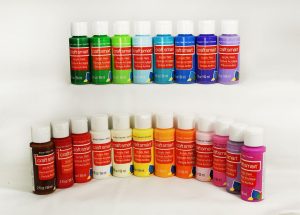
Craft Smart Acrylic Paint is a budget-friendly option that’s often found in craft stores. This paint has a decent consistency and is easy to work with, making it an excellent choice for beginners or casual Gelli printers. Although it may not be as pigmented as some professional brands, it still provides good coverage and vibrant results.
Why It’s Great for Gelli Printing:
- Inexpensive option that delivers solid performance.
- Easy to apply and spread evenly on the plate.
- Available in a variety of colors.
Best For: Beginner artists or crafters looking for a cost-effective option.
Tips for Gelli Printing with Acrylic Paint
To get the most out of your Gelli printing experience, here are a few essential tips:
- Layer Your Paint: For the best results, try layering multiple colors of paint on your Gelli plate. This creates depth and visual interest in your prints. Start with a base color, then add a second layer or texture before printing.
- Use Stencils and Textures: Incorporating stencils, fabric, lace, or other textured materials on your Gelli plate can add exciting visual effects to your prints. Experiment with different textures to see how they interact with the paint.
- Work Quickly: Since acrylic paint dries quickly, you need to work fast on the Gelli plate. You can use a slow-drying medium if you need more time to manipulate the paint before printing.
- Clean Your Plate Regularly: If you’re working with multiple layers of paint, be sure to clean your Gelli plate between prints. This ensures you don’t end up with unwanted mixed colors or smudges.
- Experiment with Transparency and Opaqueness: Different colors have different levels of opacity. Try layering transparent paints on top of opaque ones for an interesting effect.
Frequently Asked Questions
1. What is the best acrylic paint for Gelli printing?
Some of the best acrylic paints for Gelli printing include Golden Heavy Body Acrylics, Liquitex Basics, DecoArt Americana, and Matisse Structure Acrylics. Each brand offers unique features like high pigmentation, smooth consistency, and good coverage.
2. Can I use any acrylic paint for Gelli printing?
While you can technically use any acrylic paint, thicker, high-quality acrylic paints with a creamy consistency and rich pigmentation work best for Gelli printing. These paints allow you to create beautiful textures and achieve vibrant prints.
3. Is Gelli printing suitable for beginners?
Yes, Gelli printing is beginner-friendly! The process is easy to learn, and it’s a great way to experiment with different textures and colors. Choosing affordable paints and simple tools is a good way to start.
4. Can I use Gelli printing on fabric?
Absolutely! You can use Gelli printing on fabric, though it’s important to use fabric-safe acrylic paints or heat-set the prints to ensure they don’t wash out. Fabric paints are designed to adhere better to textiles.
5. How do I prevent the paint from drying too fast on the Gelli plate?
To prevent the paint from drying too fast, use a slow-drying medium or work quickly. Some artists use an acrylic retardant to extend the drying time and allow for more manipulation of the paint.
6. How do I clean my Gelli plate after printing?
To clean your Gelli plate, simply wipe it down with a damp cloth or sponge. If you have stubborn paint buildup, you can gently wash it with soap and water, but be careful not to damage the surface.
7. Can I use Gelli printing on other surfaces besides paper?
Yes, you can use Gelli printing on a variety of surfaces, including canvas, fabric, wood, and even glass. Just make sure to use the appropriate type of paint for each surface for the best results.
Conclusion
Choosing the best acrylic paint for Gelli printing is crucial to achieving beautiful, vibrant prints with rich textures. Whether you’re a beginner or an experienced artist, understanding the qualities of different acrylic paints and selecting the right one can elevate your Gelli printing projects. The paints we’ve discussed here offer a variety of options for different budgets and artistic needs, so you’re sure to find the perfect paint to complement your creative process.
With the right paint and techniques, Gelli printing can unlock endless possibilities for creating unique, textured artwork. Happy printing!


Leave a Reply